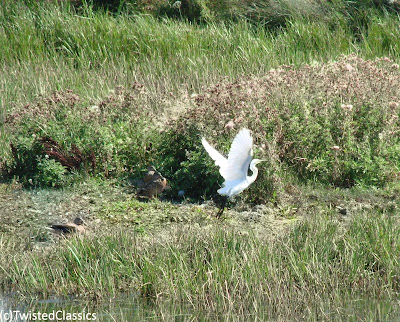In the picture below, there is one of them paddling in the water in a corner of the lagoon.
I am no bird expert, having only developed an interest in taking photographs of them in the last couple of years - due to having been given a reasonably good second-hand camera by my brother-in-law - so I am learning all the time. I believe these are Little Egrets, which have cute yellow feet, as can be seen on the flying white Egret in the photograph below.
In fact, there seemed to be white Egrets all over the marshes on that day. The photograph below was taken from one of the hides, which I sat in for a long time in order to get a break from the hot sun and to eat my lunch.
I have bought myself a bird reference book - Collins Bird Guide - which I have found to be very helpful, along with the internet, when trying to identify birds. The book gives the following information about Little Egrets: "Nests colonially in dense trees and bushes at shallow marshy lakes, rivers and coastal lagoons. Has recently colonised S England. Takes fish, frogs, insects, snails, etc. from shallow lakes, fish ponds, flooded fields and so on, often in small groups.
Identification: Medium-sized white heron, closer in size to Cattle Egret than to Great Egret, but slim and elegant. Black legs with sharply contrasting bright yellow toes. In flight, legs moderately projecting, wings look near centrally placed. Bill black; lores (part of the beak) blue-grey for greater part of the year."
In the photograph below, an Egret is taking off and has its lovely wings extended.
I have tried to enlarge the photo in order to identify what type of Egret it is - it may be the larger Great Egret as it seems to have dark coloured feet rather than yellow.
As I said earlier, the marshes seemed to be covered with white Egrets. Below are two more that were standing in another lagoon in front of another bird-watching hide. Here there were also Lapwings on view.
One of the white Egrets decided to march across the water and was obviously fishing for food.
In yet another small lagoon, there was another white Egret looking for its dinner.
It was a great day and I was absolutely thrilled to see so many white Egrets in the reserve. I only wish that I could have got much nearer to them so that I could have taken better photographs!










No comments:
Post a Comment